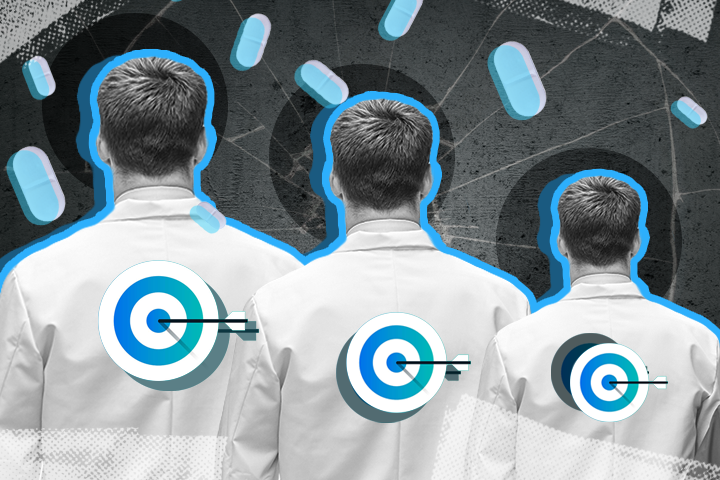
Jack wore polos in the summer and button-up shirts in the winter — never a tie. He had a briefcase he often left in the car, preferring the more discreet look of a slim folder for his promotional materials.
Other drug reps often wore suits, says Jack, a former drug rep who agreed to speak on the condition his name was changed as he still works in health care. Some even carried a mini rolling suitcase filled with pill samples, but Jack “wouldn’t be caught dead with one of those.” It marked someone too clearly as a salesperson — he wanted doctors to see him as approachable, like a friend.
“I was going for the long game,” he says. “My goal was to establish a relationship and get comfortable with (doctors) to be able to have more effective ‘closes.’”
READ MORE: Doctor-prescribed addiction: How these Canadians got hooked on opioids
Jack’s deliberately casual approach belies the preparation he did. He knew all about the doctors he pitched: the types of drugs they prescribed and their brands of choice. Sometimes, he even knew their coffee order and whether they were vegetarian.
He would use that information to orchestrate a conversation that felt productive, he says, “like I’m trying to help (the doctor), rather than shove a message down their throat.” A productive conversation boosted his odds of closing a sale.
Although drug companies have made headlines over the ethics of treating doctors to fancy meals and inviting them on expensive trips, experts say those small, carefully thought-out day-to-day interactions are just as worrisome. Drug reps are swaying the prescribing habits of Canadian doctors — and their patients are often unaware.
WATCH: Opioids and drug rep pitching. Caryn Lieberman reports.

Are drug reps educators, marketers or both?
Tristan, who also spoke on the condition of anonymity, sells respiratory drugs for a Canadian pharmaceutical company. He sees himself as an educator.
Many doctors are so busy they don’t take time to learn about new products themselves, Tristan says, so it’s his job to fill that knowledge gap by stopping by doctors’ offices or taking them to lunch.
Tristan meets with around 20 to 30 doctors on a weekly basis, although that number depends on their schedules. Some doctors will simply turn him away.
Still, Tristan is adamant about getting his message across because he feels doctors need that education. Just think, he says: if a doctor graduated in 2009, that means “10 years of not learning anything new… they’re way behind in the industry — especially in the industry now, with the amount of science that’s going at a faster pace than ever before.”
WATCH: How pharmaceutical reps lobby doctors to use their drugs

That isn’t how Dr. Jeff Sisler sees it.
Sisler is an executive director at the College of Family Physicians of Canada, the professional association that certifies doctors in Canada. What Tristan calls educational, Sisler calls “marketing” with a little bit of education sprinkled in.
Doctors have “ample opportunities” to get information about the effectiveness of a drug from sources outside of the company that makes them, Sisler says.
“We don’t think there’s a problem with getting access to information in a way that’s more neutrally created.”
Drug reps aren’t a neutral source of information, adds Sergio Sismondo, a Queen’s University philosophy professor and author of Ghost-Managed Medicine: Big Pharma’s Invisible Hands.
That’s because their clear goal is selling products and making money — an objective Sismondo says rarely aligns perfectly with what’s best for patients.
Research shows new drugs are often heavily promoted by companies early in their life cycle, whether or not there’s evidence to show their effectiveness.
WATCH: Family physician says drug reps give doctors biased information

Since the mid-1990s, independent reviews have found that “about 85 to 90 per cent of all new drugs provide few or no clinical advantages for patients,” according to an article published in the medical journal BMJ in 2012.
In his book, Sismondo wrote about Prescrire, an independent health-care organization that evaluated 92 new drugs in 2016 and found there were “no breakthroughs, one ‘real advance,’ five that ‘offer an advantage,’ nine that are ‘possibly helpful,’ 56 that offer ‘nothing new’ and 16 that were ‘not acceptable.’”
Still, new drugs are often easier to promote.
“New medicines have a steep year-over-year uptake in sales,” a 2018 Canadian government report found.
“Any time that a company is interested in making a profit (and) has an enormous influence on what people do for their health… we can basically assume that that’s not in people’s interests,” Sismondo says. “There’s always going to be some divergence.”
How drug reps talk to your doctor
Pitching a product to doctors is a well thought out act: drug reps are salespeople, doctors the target consumer. Still, the sales pitch is designed to feel like a conversation between old friends. Remember Jack? Polos, button-ups, hold the tie.
Jack worked for a drug company for two years, pitching specialists on a drug used to treat rheumatoid arthritis. He always knew what he was going to say well in advance of meeting with a doctor, although “the style and cadence” change depending on who you’re talking to, he says.
READ MORE: ‘Not in My Backyard’: How NIMBYism impacts access to vital support services
If a drug rep is stopping by a doctor’s office unannounced, they may have only a few moments with a doctor. In those cases, Jack says sticking to a concise script is useful.
Drugs reps are “just carpet-bombing,” Jack says.
“They’re saying: ‘Use Drug X, use it once a day, it’s easy for the patient and here’s a sample.’ Then off you go.”
When Jack visited specialists, he’d often make appointments in advance and get 15 to 20 minutes to make his pitch.
The key was avoiding “robotic” pitches, he says, advice gleaned from market research his company did. Doctors were more responsive to drug reps who listened to their concerns, says Jack, so he adjusted his “personal script” to do that.
There are plenty of other “tactics for manipulating physicians,” wrote Adriane Fugh-Berman, director of PharmedOut at Georgetown University Medical Center, and Shahram Ahari, a former drug rep, in their journal article Following the Script.
Which tactic a drug rep takes will depend entirely on the doctor they’re pitching, they wrote. Ahari would switch up his tactics for doctors prescribing a competitor’s drug, starting by figuring out why they were using other drugs.
[section title=”How drug reps know which doctors to pitch — and which to avoid”]
The majority of Canadians have no idea how powerful pharmaceutical companies are, says Sismondo. Because drugs are not selected by a patient, it is up to a doctor to determine which products to prescribe. Doctors are the middlemen.
“In order to sell a drug, there needs to be a prescription, so a significant portion of the effort in marketing drugs is marketing to doctors,” Sismondo says.
They do this armed with data.
When Jack was a drug rep, his company relied on prescription data from Intercontinental Medical Statistics, which has since been folded into IQVIA, a health data company. IQVIA buys data from places like pharmacies and sells it to drug companies. While this data doesn’t include patient information, it does identify individual physicians and the drugs they’ve prescribed.
WATCH BELOW: Toronto physician says Purdue Pharma lied about opioid safety

That information is incredibly valuable because it helps drug reps determine which doctors they should pitch. Let’s say Dr. John commonly prescribes a certain brand of antidepressant; a drug rep selling a competing brand could go try to pitch him an alternative.
These interactions can be really successful as research shows drug reps can influence doctors’ prescribing habits — and it may not even take a lot. One study found doctors who were bought a meal by a drug company were associated with an increased rate of prescribing the brand-name medication that was being promoted.
Another 2017 study found that drug industry-physician interaction affected doctors’ prescribing habits and was “likely to contribute to irrational prescribing of the company’s drug.”
High performers at Jack’s old company were rewarded with bonuses for meeting their sales goals, he says — sometimes to the tune of $20,000.
Who’s monitoring the drug companies?
In May, Canadian law firm Koskie Minsky launched a $1.1-billion proposed class-action lawsuit against 28 drug companies. The allegations in their statement of claim directly implicate the sales tactics of drug representatives.
In the 1990s, drug companies, including Purdue Pharma, Apotex Inc., Bristol-Myers Squibb and Janssen Inc., spent hundreds of millions of dollars to promote the use of opioids for conditions like migraines, arthritis and back pain in an attempt to make more money, the suit alleges.
READ MORE: Inside an Ontario fentanyl trafficking ring involving a doctor and a pharmacist
It claims the companies “relied heavily on sales representatives” to provide doctors and other health-care prescribers with false information over in-person meetings and all-expense-paid dinners and trips.
No statement of defence has been filed, but a spokesperson for Purdue Pharma Canada told Global News it is “deeply concerned” about the ongoing opioid crisis and “continuing to review the lawsuit.” A spokesperson for Bristol-Myers Squibb said it “does not comment on pending litigations.”
A spokesperson for Janssen Inc. also acknowledged the opioid crisis but said the allegations against the company are “not consistent with the facts.” Janssen Inc. no longer promotes its prescription opioids, the spokesperson said, but when it did, their promotion was “responsible and appropriate.”
The federal government says it is treating the opioid crisis as a top public health priority, but Sharon Batt, a bioethics professor at Dalhousie University, doesn’t think that’s made the average Canadian more aware of the “subtle kinds of marketing strategies” drug reps use.
And why should it have, wonders Batt, whose expertise is in the pharmaceutical industry and conflicts of interest in medicine. One analogy she finds effective is that a person’s relationship with their doctor is often like that of a couple, and the drug rep is the person with whom the doctor is having an affair.
“They’re seeing this person, and that’s going to impact your relationship with the doctor in ways that aren’t good for you, but what power do you have, really?” Batt says.
WATCH BELOW: ‘Your heart breaks’: Ontario woman shares how her brother got addicted to opioids

Health Canada steps in when it becomes aware of “false, misleading or deceptive” advertising, according to a spokesperson. It does that, in part, through industry partners.
The Pharmaceutical Advertising Advisory Board (PAAB) is in charge of vetting the materials drug reps bring with them when they meet with doctors. The advisory board was created in the 1970s as a result of misleading ads that were “causing physicians to prescribe inappropriately,” says PAAB acting commissioner Patrick Massad.
Opioids are the only drug for which PAAB pre-screening is mandatory, Massad says. For the most part, the board’s pre-screening is voluntary. If PAAB sees advertising material aimed at medical professionals that isn’t appropriate, it will attempt to fix it with the company, referring refusals to Health Canada.
Regardless, PAAB doesn’t oversee what those drug reps say to doctors when they meet with them — that’s Innovative Medicines Canada’s job. IMC is one of the industry’s main lobbying groups, representing 41 drug companies whose membership requires them to abide by a code of ethics that includes providing “full and factual information on products, without misrepresentation or exaggerations” and allows for sales over the occasional meal and refreshments.
A spokesperson for IMC declined an interview, sending a statement that says members must follow the code of ethics. Global News reached out to half a dozen drug companies, all of which declined an interview discussing how they train representatives.
A spokesperson for Bristol-Myers Squibb Canada said it couldn’t do an interview due to the “proprietary nature” of that training but said its members “operate at all times with the utmost ethics and integrity.”
READ MORE: Blood Tribe killer: Pregnant woman in detox shares struggle with opioid addiction
And yet, the incentivizing of sales can have “an enormous effect” on which drugs are sold and to whom, says Sismondo, the pharmaceutical industry expert.
“Occasionally, they slap themselves on the wrist for violating their own policies,” he says. But even then, it’s maybe a $10,000 fine — “amounts that just don’t matter,” Sismondo explains.
IMC has only a dozen complaints listed publicly on its website from 2010 through 2018. It found breaches of industry code in only two cases.
The government should be more involved, says Sismondo, stepping in and debating whether the prescription data on which drug companies rely to pitch doctors should even be sold.
“I think we should start thinking about whether, in Canada, there should be a role for sales representatives at all,” Sismondo says.
“Holding the pharmaceutical industry further apart from the practice of medicine and the education of doctors would be a really good step.”
Why you should watch out for drug samples
Sometimes, it’s possible to tell if your doctor sees drug reps, says Batt. Occasionally, there will be a sign in the waiting room indicating salespeople will only be seen for five minutes at most. One other very clear indication, Batt says, is drug samples.
Most Canadian doctors see drug reps. According to a 2009 survey from Prism Healthcare Intelligence, only seven per cent say they don’t. Of the majority who do, 88 per cent say they see sales representatives for information while 85 per cent said they see them for samples.
“It’s a very subtle marketing tactic,” says Batt. “It’s a gift and it initiates this whole expectation of reciprocity.”
Someone might start on a free sample of a drug, she says, but then they’ll often continue on it once it’s no longer free because they’ve already started.
That’s a problem, Toronto emergency room physician Joel Lexchin wrote in The Conversation, because “nearly all of the samples are for new, expensive drugs — ones that companies are eager to see doctors prescribing.” Once a doctor prescribes these costly drugs, he wrote, “they end up costing patients, private and provincial drug plans more and they expose patients to products that may be unsafe for them.”
WATCH BELOW: How climate change is making the opioid crisis worse

Dr. Abhimanyu Sud, academic director of the Safer Opioid Prescribing program at the University of Toronto, says samples are only one way drug reps land sales. He says reps want to be the go-to source for drug information and establish themselves as part of a health-care team — even though they’re not medical professionals.
“I really don’t have a lot of confidence in their ability to interpret health information, medical information and medical evidence,” Sud says. “They’re primarily marketers and promoters and they have a specific bundle of information they want to provide. They are not the kind of people to have an informed discussion about the appropriateness of a medication.”
What’s more, Sud says there are programs in Ontario where unbiased pharmacists can come to doctors’ offices and give them advice on certain products. He says these outside experts are a more credible source of information.
Fugh-Berman, the PharmedOut director, says more doctors should favour impartial sources over reps.
“Doctors think they can extract the good information from the bad, and they can’t. That’s been documented,” she says.
“It’s a whole network of influence that’s all meant to make physicians more susceptible to marketing messages about drugs, and patients should absolutely care about that because the information… they’re getting is inaccurate.”
— With a file from Caryn Lieberman
Laura.Hensley@globalnews.ca
Jane.Gerster@globalnews.ca





Comments